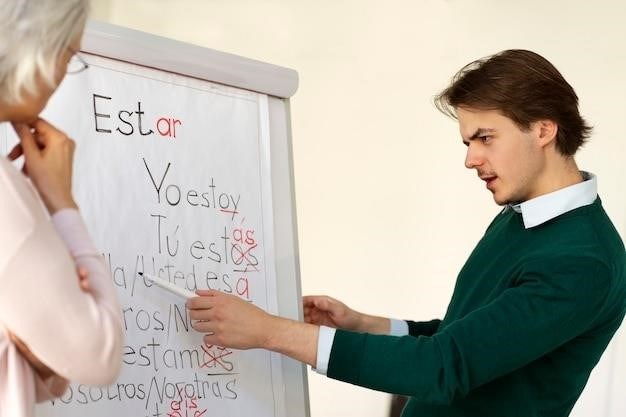Interactive Grammar Tutorial⁚ Forming Questions in Spanish
This interactive grammar tutorial will guide you through the process of forming questions in Spanish using inverted word order. You will learn how to identify the subject of a sentence, place the verb in the correct position, and understand the role of the subject in forming questions. By the end of this tutorial, you will be able to confidently ask questions in Spanish with confidence!
Introduction
Welcome to this interactive grammar tutorial on forming questions in Spanish! This tutorial will help you master the art of asking questions in Spanish, a fundamental skill for any language learner. While English typically places the question word at the beginning of a sentence (e.g., “What is your name?”), Spanish employs a different approach, using inverted word order. In this tutorial, we’ll explore how this unique structure works and how it can be applied to various question types.
We’ll delve into the key elements of forming questions in Spanish⁚ understanding inverted word order, the role of the verb, and the placement of the subject. We’ll also discuss the use of question marks in Spanish, which differ slightly from their English counterparts. Throughout the tutorial, we’ll provide examples of inverted word order in action, helping you visualize and practice this essential grammatical concept.
Get ready to enhance your Spanish skills and unlock the power of asking questions with confidence! Whether you’re a beginner or looking to refine your existing knowledge, this tutorial will equip you with the tools and understanding to effectively communicate in Spanish. Let’s embark on this exciting journey of learning!

Understanding Inverted Word Order
In Spanish, questions are formed using a technique called “inverted word order.” This means that the usual order of subject, verb, and object is reversed. Unlike English, where we typically place the question word at the beginning (e.g., “What is your name?”), Spanish often places the verb before the subject in questions. This might seem a bit unusual at first, but it’s a crucial aspect of Spanish grammar.
Imagine a simple statement in Spanish⁚ “El gato come el pescado” (The cat eats the fish). To turn this into a question, we would use inverted word order, placing the verb “come” before the subject “el gato”⁚ “Come el gato el pescado?” (Does the cat eat the fish?). Notice how the verb “come” now precedes the subject “el gato.”

Understanding this inverted word order is essential for forming grammatically correct questions in Spanish. Don’t worry if it feels unfamiliar at first; we’ll break down this concept further in the following sections, providing clear examples and explanations to help you master this skill.
The Role of the Verb
The verb is the heart of a sentence, carrying the action or state of being. In Spanish questions, the verb plays a crucial role in determining the question’s structure. It’s the verb that moves to the front of the sentence, initiating the inversion that characterizes Spanish question formation.
For example, in the sentence “Ella estudia español” (She studies Spanish), the verb “estudia” (studies) is the key element. To make this a question, we move the verb “estudia” to the beginning, creating “Estudia ella español?” (Does she study Spanish?).
Remember, the verb will always be the first element in a Spanish question formed with inverted word order. This makes it easy to identify a question, as the verb will always be in the first position. This rule applies to all types of questions, whether they are asking about a subject, object, or any other element in the sentence.
Subject Placement
In Spanish questions formed with inverted word order, the subject takes a backseat, moving to the end of the sentence. This change in subject placement is a key characteristic of Spanish question formation, and it’s what distinguishes a question from a statement.
Think of it as a subtle dance⁚ the verb takes the lead, initiating the question, while the subject gracefully follows behind. This movement creates a sense of inquiry, drawing the listener’s attention to the information being sought.
For example, in the statement “El perro come la comida” (The dog eats the food), the subject “el perro” (the dog) sits comfortably at the beginning. To turn this into a question, we move the subject to the end, creating “Come el perro la comida?” (Does the dog eat the food?). This rearrangement makes the sentence a question, emphasizing the desire to know if the action described actually took place.
Question Marks in Spanish
Spanish utilizes a unique feature in its question formation⁚ the inverted question mark. This symbol, placed at the beginning of a question, acts as a visual cue, signaling that the following sentence is an inquiry. It’s like a friendly flag waving, alerting the reader to prepare for a question.
This distinctive practice distinguishes Spanish from many other languages where a simple question mark at the end suffices. The inverted question mark provides a clear indication that a question is being posed, making it easier for readers to understand the intended meaning.
Think of it as a visual guide, helping to navigate the flow of information. The inverted question mark at the start and the regular question mark at the end create a visual frame, enclosing the question within a distinct structure. This visual emphasis ensures that the question stands out, making it clear that an answer is being sought.
Examples of Inverted Word Order
Let’s dive into some practical examples to solidify your understanding of inverted word order in Spanish questions. Imagine you’re trying to find out if your friend is working on Saturdays. You would ask⁚ “¿Trabajas los sábados?” Notice how the verb “trabajas” (work) comes before the subject “tú” (you) in the question. The inverted question mark at the beginning signals the question, and the standard question mark at the end completes the structure.
Let’s look at another example⁚ “Do you like to dance?”. In Spanish, you would say⁚ “¿Te gusta bailar?”. The verb “gusta” (like) comes before the pronoun “te” (you), and the subject “bailar” (to dance) follows. This structure, with the inverted question mark, clearly identifies the question.
Now consider the sentence, “Does Carlos live in Madrid?” In Spanish, it becomes⁚ “¿Vive Carlos en Madrid?” Again, the verb “vive” (lives) comes before the subject “Carlos”, and the inverted question mark signals the question. Remember, the subject always comes at the end of the sentence in Spanish questions.
Practice Exercises
To solidify your understanding of forming questions in Spanish, let’s engage in some practice exercises. These exercises will help you apply the concepts you’ve learned and build your confidence in creating questions using inverted word order.
Exercise 1⁚
Transform these statements into questions⁚
- La clase termina a las dos. (The class ends at two o’clock.)
- Ustedes trabajan los sábados. (You work on Saturdays.)
- Carlota busca un mapa. (Carlota is looking for a map.)
Exercise 2⁚
Create questions based on the following prompts⁚
- Where do you live?
- What time does the movie start?
- Do you like to read?
Remember, you can always refer back to the previous sections for guidance if needed. Good luck, and have fun practicing!
Additional Tips
While mastering the basics of inverted word order is crucial, a few extra tips can enhance your question-forming skills and make your Spanish sound more natural. Let’s explore some helpful strategies⁚
Practice with Different Verb Tenses⁚ Don’t limit yourself to the present tense; Practice forming questions in various tenses, such as the past tense (preterite and imperfect) and the future tense. This will expand your ability to ask questions about different situations and timeframes.
Incorporate Question Words⁚ Expand your question-asking repertoire by incorporating question words like “quién” (who), “qué” (what), “cuándo” (when), “dónde” (where), “cómo” (how), and “por qué” (why). These words will allow you to ask more specific and nuanced questions.
Listen and Observe⁚ Pay close attention to how native Spanish speakers ask questions. Listen to conversations, watch Spanish-language movies or television shows, and observe how questions are constructed. This will provide you with valuable insights and help you develop a natural ear for Spanish questions.
Remember, learning a language takes time and practice. Be patient with yourself, and don’t be afraid to make mistakes. With consistent effort, you’ll be able to form questions in Spanish with ease and confidence.
As we conclude this interactive grammar tutorial, you now possess the fundamental tools to confidently ask questions in Spanish using inverted word order. You’ve learned about the key elements of question formation, including subject placement, verb positioning, and the significance of question marks. By putting these concepts into practice, you’ll be able to communicate effectively and engage in meaningful conversations with Spanish speakers.
Remember, learning a language is a journey. It’s about embracing the challenges and celebrating the successes. Don’t be afraid to experiment, make mistakes, and learn from your experiences. The more you practice, the more fluent and comfortable you’ll become in asking questions in Spanish.
As you continue your Spanish language learning adventure, consider exploring additional resources and engaging in real-world conversations. This will help you solidify your understanding of Spanish grammar and vocabulary, and enhance your overall language proficiency. Most importantly, enjoy the process of learning and the rewards of being able to communicate effectively in a new language.
Resources
To further enhance your understanding of question formation in Spanish, consider exploring the following resources⁚
- Online Grammar Websites⁚ Websites like StudySpanish.com and Lingolia offer comprehensive lessons and interactive exercises on Spanish grammar, including question formation. These platforms can provide valuable insights and practice opportunities.
- Spanish Textbooks and Workbooks⁚ Textbooks and workbooks designed for Spanish language learners often include dedicated sections on question formation, providing explanations, examples, and practice exercises.
- Spanish Language Apps⁚ Language learning apps like Duolingo and Babbel incorporate interactive lessons and quizzes that cover various grammar concepts, including question formation. These apps offer a convenient and engaging way to practice your skills.
- Spanish Dictionaries and Grammar References⁚ Dictionaries and grammar references can be valuable tools for clarifying grammar rules and understanding the nuances of question formation in Spanish.
- Online Forums and Communities⁚ Join online forums and communities dedicated to Spanish language learners. You can ask questions, share your experiences, and learn from others who are on a similar journey.
Remember, there are numerous resources available to support your Spanish language learning journey. Utilize these tools effectively to deepen your understanding of question formation and enhance your overall fluency.
Further Exploration
Beyond the basics of inverted word order, there are several intriguing aspects of question formation in Spanish that you can explore further. Here are some avenues for continued learning⁚
- Question Words (Interrogative Pronouns)⁚ Dive into the use of question words like quién (who), qué (what), cuándo (when), dónde (where), cómo (how), and por qué (why) to formulate more complex questions.
- Indirect Questions⁚ Explore the nuances of forming indirect questions, which are embedded within a larger sentence.
- Formal and Informal Questions⁚ Understand the distinction between using usted (formal “you”) and tú (informal “you”) in question formation, and how this affects verb conjugation and word order.
- Regional Variations⁚ Investigate regional variations in question formation, as some dialects may have unique sentence structures or word order preferences.
- Idioms and Expressions⁚ Discover how idiomatic expressions and common phrases are used in question formation, adding a touch of cultural nuance.
By delving deeper into these advanced concepts, you can gain a more comprehensive understanding of question formation in Spanish, enabling you to communicate effectively and navigate diverse conversational situations.



